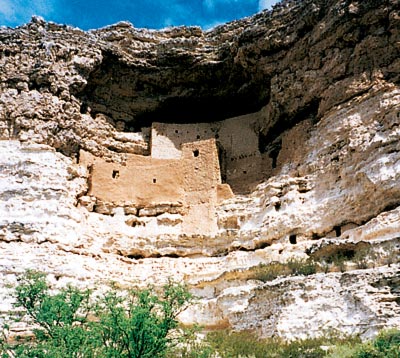Montezuma Castle and Walnut Canyon, Arizona

When it comes to tourist attractions, the Grand Canyon gets marquee billing–and justifiably so. But while stationed at the Grand Canyon with the National Park Service, my husband and I discovered many hidden gems nearby that deserve a share of the spotlight.
I'm referring to Montezuma Castle, Walnut Canyon, Sunset Crater Volcano and Wupatki National Monuments, homes to the Sinagua (which means “without water” in Spanish) hundreds of years ago. These peaceful people disappeared mysteriously ages ago, but the monuments–all within easy driving distance of Flagstaff, Arizona–stand as stoic reminders of their culture.
Montezuma Castle, about 50 miles south of Flagstaff and just 3 miles east of I-17 (Exit 289), is an amazing piece of prehistoric architecture. The 20-room, five-story “castle” is set in the cavity of a vertical cliff face.
This protected site gave the Sinagua an expansive view of Beaver Creek and the lush Verde Valley–an oasis in an otherwise harsh landscape.
Sunset Crater Volcano, about 12 miles north of Flagstaff, just east of U.S. Highway 89 (take the Sunset Crater-Wupatki Loop Road), features a 1,000-foot-high volcanic cone that seems to glow at sunset. Visitors can hike a cinder cone on the steep Lenox Crater Trail or explore–very carefully–the lava flows. The solidified lava is brittle, razor-sharp and very unstable.
If you follow the Sunset Crater turnoff farther north, you'll reach Wupatki National Monument, a large prehistoric dwelling that stands alone on a huge boulder in the middle of nowhere. It offers a breathtaking desert view.
The larger multi-level Wupatki Pueblo contains more than 100 rooms. These dwellings were abandoned around 1225 but remain amazingly intact.
All these monuments conjure up vivid images of an ancient society struggling to survive, but none stirred my heart like Walnut Canyon, about 8 miles east of Flagstaff, just south of I-40 (Exit 204). These ancient dwellings, nestled in limestone walls across a deep gorge, were created by the Sinagua women between 1125 and 1250.
As I knelt in one of the dimly lit rooms, a young couple entered through the short doorway. After the man repeated every word he'd read on the interpretive exhibit outside, we sat in silence for a long time, awed by the fact that this dwelling had sheltered a family more than 700 years ago.



Leave a Reply